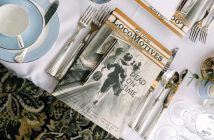Getting a bullet to land in the same place each time is more than just a skill. It takes some real mental discipline, as Nick Harman discovers…
“It’s a bit like golf, only with rifles,” my coach tells me as I lower myself to the ground. “You’ve got to make the perfect shot in itself, but you also have to gauge the wind perfectly too…”
I’m lying on the 300-yard firing point at Bisley, home of Britain’s shooting. If you’re unfamiliar with the name, Bisley is to shooting what Lords is to cricket. The 300-yard firing point is as close as you get in the discipline of Target Rifle. Behind us, Century Range (it has 100 targets) stretches back to 600 yards. On another range, Stickledown, ten minutes’ walk away, the targets are 900, 1000 and 1200 yards away. That’s 400 metres short of a mile.
At 300 yards, the entry level, I don’t have to worry about the wind too much. If you want the specifics, the 7.62mm NATO bullet – the classic British .303 was phased out some years ago – weighs in at 121.9g and leaves the barrel at 2,356 feet per second. So, at this short distance the wind has little effect on its travel.
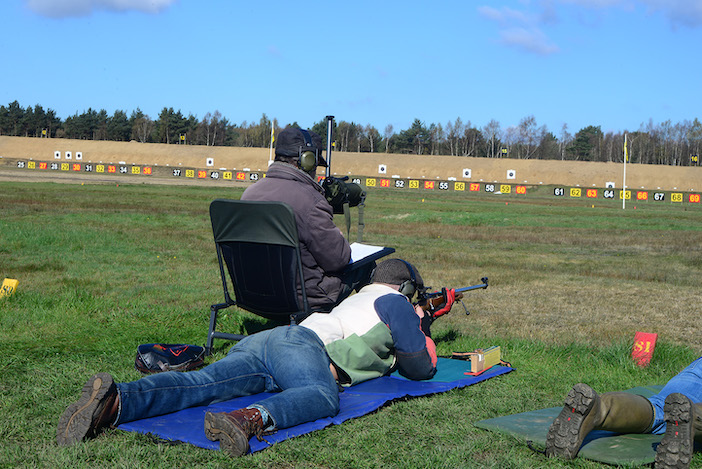
My target is a black disc of paper made up of a 5-point bullseye, the 4-point or ‘inner’ ring, then the 3-ring or ‘magpie’, finally the white ‘outer’ for 2 points. Within the bullseye is a smaller ring called a ‘V bull’. This ‘super bull’ is the place to be. Top shots will usually get all bullseyes, what makes the difference to winning or losing is how many Vs they get.
I’m told all this as I tuck the long rifle into my shoulder. Target Rifles are single shot rifles, they have no magazines because they need to be as rigid as possible to shoot to the consistent accuracy required. They are designed purely for the purpose, in fact they are all but useless for any other job. This is not a sport for the ‘gun nut’. And they aren’t cheap. A used good quality TR rifle will cost you around £1900, and you can pay a lot more for something brand new.
With a padded glove on my left hand and a strap attached from the underside of the rifle to my left upper arm, I get into position. Using physics I should have learned at school, the strap – or sling – transfers the job of supporting the heavy weight of the rifle away from my left arm to my whole body. Suddenly it feels much lighter and steadier. This is why, I am told, many older people, women and young girls target shoot. Strength is not a factor in success. It’s all in the mind.
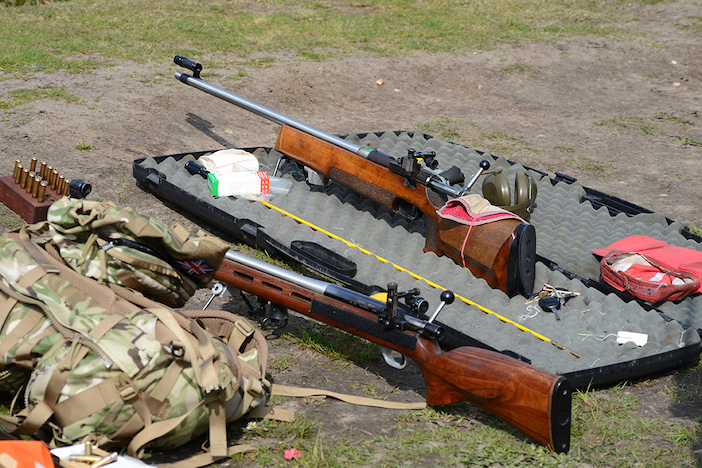
I rather expected at this point to be peering down a telescopic sight, having seen many action films, but TR is what is called ‘iron sights’, that is no glass. At the front of the barrel, on the business end, is mounted a shrouded fixed metal ring about 1mm or so in diameter, and at the back is another metal ring in a moveable carriage. The target is the black dot in the distance. Centralise the black dot between the two rings, fire, and the bullet should pass through the center of the target giving you a bullseye, maybe even a V bull.
Well, that’s the theory.
My coach radios “Message 1” to the butts 300 yards away. There are a number of numbered ‘messages’ to communicate with the butts that have been used since the shooting grounds moved here from Wimbledon Common in 1889. This one means ‘raise target’. And from under the steel and earth shelter in the distance a small target frame judders into view. From here the black dot is a pinprick in my sights, despite being some 16 inches across. The invisible V bull in the centre, is just 3.3 inches.
Following my coach’s instruction, I move about a bit until the rifle is naturally pointing at the dot, even when my arms are relaxed. “If you have to use your muscles to point at the target then the moment you fire, the arm will relax back to its true resting point and the shot will go wrong,” says Bill, peering down his spotting telescope.
Bullet into the breech, bolt forward and locked down. Then into the aim, breathe in, breathe out and the sights rise up the target, and then down with your chest movement. The method is, when ready, to take one final deep breath, exhale half of it so that the rifle stops its descent on target, hold your breath, check your aim is good, empty your mind of distracting thoughts, and fire.
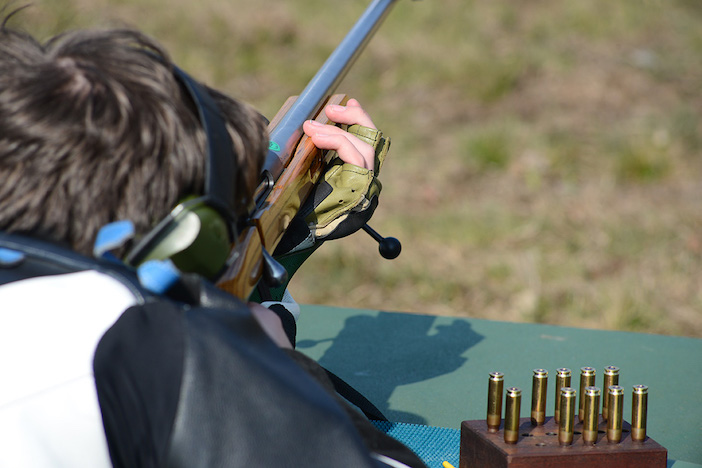
I don’t fire. Although I’ve taken up the trigger’s first pressure, I can’t quite make the gun go off with my gentle squeezing. “Okay,” says Bill, “stop and start the breathing sequence again”. Apparently, if you hold your breath for too long the mind ‘panics’ about oxygen and the muscles tense, your vision blurs and you lose the calm required.
I do it again; breathe out, hold still, steady aim, think nothing, gently squeeze, and…wallop! There’s an almighty great bang, even though I’m wearing ear defenders, and my right shoulder flies backwards with the recoil.
“Good,” says Bill, as I lower the rifle and eject the empty case. A few seconds later the target frame descends out of sight, hauled down by the invisible team alerted to the shot by the crack of the bullet passing overhead, through the target and into the sandbank behind.
After a few moments it wobbles back up. On the bottom of the frame is now hung a board visible with the naked eye. If it’s on the far right, it tells us the shot was a bull 5 (if the board is far right and orange, it’s a V bull), just in from the right, it’s an inner 4 and so on.
My board indicates Magpie 3. The bullet hole itself now has a fluorescent marker disc stuck in it which can be seen by Bill’s spotting scope. He marks the hole’s position on a target diagram in front of him and shows me. Very low and off to the right. Still, I’m pleased I hit the target at all.
Using the marked squares on the diagram Bill works out that, assuming I shot well, then the sights need to come up two minutes of elevation (eight clicks on the adjusting wheel) and a minute left (four clicks on the other wheel) to counter the wind.
I go again. This time I hang in the aim too long and rather than start again I jerk the trigger, Big mistake, the shot is wildly out in the two ring. A tiny amount of barrel movement means inches at the far end, even whole feet.
After the regulation 12 shots – two to sight and ten to count – my target diagram has shots all over the place. “A good shot needs to be able to group the two sighter shots tightly together in one place before adjusting for wind,” says Bill. “Otherwise you’re not adjusting at all, you’re just chasing your mistakes and that will get you nowhere.”
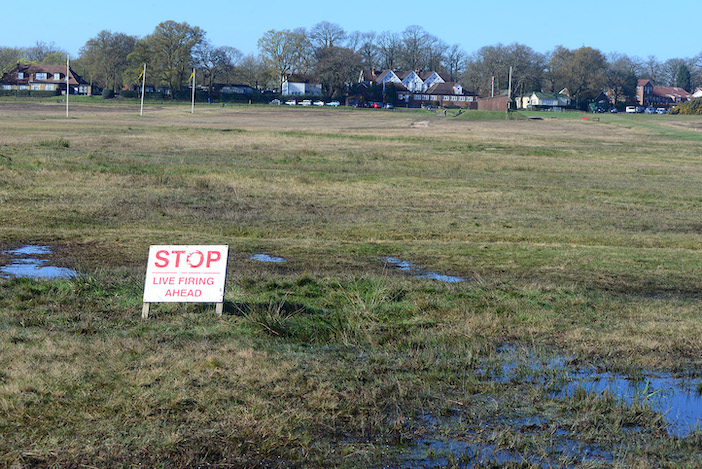
We hike on over to the 1000-yard range, passing the many county clubhouses on Bisley ‘camp’, most of them physically brought here from Wimbledon in 1889. One looks like a circus tent, many emulate the houses of the Raj with verandas all round, most have a bar and serve food. Bisley Camp is a place in a genial time warp.
But then target shooting is a genial sport; no-one around here is wearing camouflage, or suchlike. The general dress code seems to be what you might wear to go gardening, although younger shots favour baggy shorts and flip flops. The only common item of clothing is the ubiquitous shooting jacket, designed to hold the sling securely and support the user when shooting.
From the 1000-yard point we can see the targets, now incredibly far away, and behind them the green Surrey countryside stretching all the way to the horizon. This is the ‘dead zone’. No one is allowed in it during shooting days so any bullets which should somehow pass over the sand banks will run out of energy and fall harmlessly to the ground long before they reach civilization.
At this distance only the bull and the inner are coloured black and their combined diameter is four feet. The entire target circle is a whopping nine feet in diameter. How can you miss a target nine feet across? I ask myself.
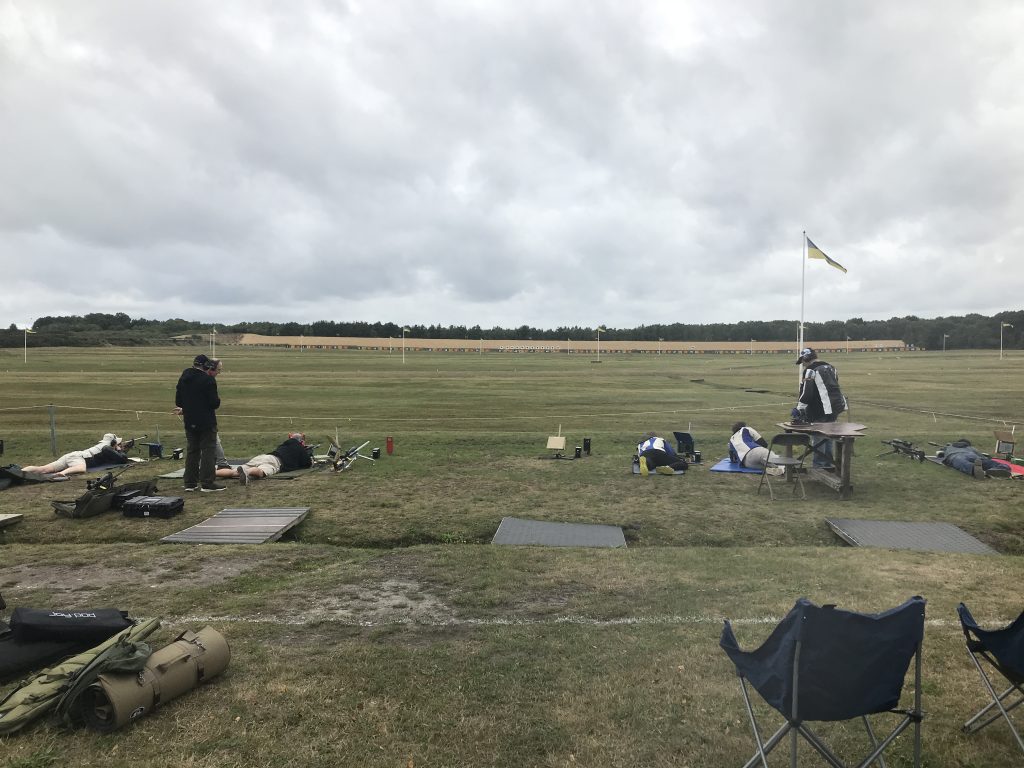
Well, quite easily as it turns out. The black dot seems tinier than ever, but now the wind is a serious problem. We look at the flags dotted all over the range and how much they are flapping and in which direction. Bill calculates today we need to initially set the sights to aim a good ten feet to the right of the target so that the prevailing wind will push the bullet into the right place. He will also adjust my sights while I am in the aim if he sees wind change coming.
The sights are then raised by a calculated amount to allow for the bullet dropping as it goes down the range. If you could watch the bullet fly in slow motion you’d see it first travel up very steeply, whilst heading off toward a target three doors down. Then it would slowly descend, curving elegantly back with the wind to land on the target. Just like a long range golf shot. For the shooter though, the mental illusion is still of a bullet travelling parallel to the ground and straight onto the target.
I try to rid my mind of that concept, my thoughts of dinner, and the song that seems to have got stuck in my head, and achieve the zen calm needed. I fire and we wait, and wait. ‘Message four!’ Bill radios to the butts. This means ‘the shooter has fired, but you have not noticed’, although Bill explains it to me in more colourful language,
The target goes down, it comes up, no marker board and no shot hole. ‘Clear target’ comes from the butts. So, I’ve missed the whole thing, the target and the frame the size of a transit van.
A combination of wind error but mostly my error. Bill reduces the wind correction and I carefully go again and this time, gratifyingly, the frame descends without prompting. I’ve just got into the three ring and high.
“One guide you have,” Bill explains, “is that if the last shot was correct for height, but off to one side, then it’s more likely to have been a mistake reading the wind than a bad shot. Don’t ever correct your sights for a bad shot.”
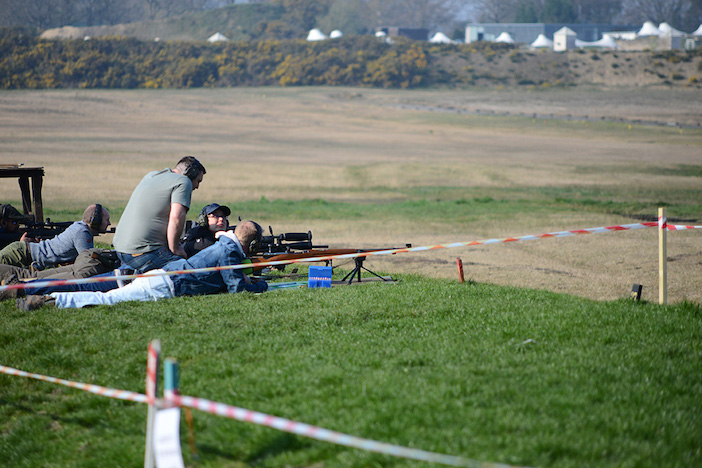
I carry on, still scattershotting across the target, but on the seventh the marker shows a V bull. ‘Nice one.’ says Bill, ‘you see, it can be done.’ Sadly, the butts soon radio to tell us that it hadn’t been a V bull after all; the paper patch had blown off from a hole made by a previous shooter and they’d not initially realised. My own shot had been way off.
As we pick up the kit to head off to the clubhouse and a satisfying pint, I find myself feeling oddly exhausted for someone who has spent most of the afternoon lying down. “It’s all the concentration, the mental effort,” says Bill. “It does take it out of you if you’re not used to it. It’s a mental and physical challenge, and it’s addictive.”
It is. I feel the desire to do it again, to get better, and to one day be one of around 1000 shooters from around the world who come to Bisley each August for three days to shoot at all distances at the Imperial Meeting. Their aim (sic) is to try and get into the final 100 at 1000 yds to emerge the winner of the Queen’s Prize, an accolade hotly fought for since 1860. The prize is a Gold Medal and £250 ‘from the Sovereign’s purse’.
This is certainly not a sport for making a large fortune, but if you’re looking for something that is both an individual and a team sport, and one that can be done at almost any level of fitness or age, then focus your mind on target shooting.
Find out more about getting into fullbore shooting in the UK, and what clubs are near you, via the NRA Website. There are fullbore ranges around the country and most clubs have rifles and equipment for new members to borrow. Please note the UK NRA exists to promote the sport of target shooting and has no connection with the American NRA, which exists for a different purpose entirely.




